CHETAN MAHARAJ LOGO
Bhagvat Kathakar-
Chetan Thakar
-
November 24, 1974
-
Bhuj, Kutch-Gujarat
-
contact@chetanmaharaj.com
-
+91 982-513-1443 +91 840-192-2600
No human beings ever at any moment remain aloof of deeds for a while, but by virtue of inherent characteristics created by Nature, they being dependent on others perform the deeds.
SATSANG is our class.
SANGAT is our classmates.
MANDIR (TEMPLE) is our school.
GURU VANI (PRECEPTER’S DISCOURSE) is our syllabus.
SEVA (SERVICE) is our practical deed/action.
SIMRAN is our test.
ISHWAR (GOD) is our examiner.
KARMA is our obligation/duty.
FAL is our result.
Shrimad Bhagwat Saptaah:
This religious occasion through a ritualist (Maharaj/Pandit) is generally organized and celebrated by any host/s of that family, who want to desire willingly and religiously to get rites performed for emancipation of their ancestors’ souls that passed away. It is also observed and got performed for bringing happiness and peace in a family. This occasion, from the beginning to accomplishment, continues for a week, without any break, except intervals during the continuation from morning to eve. That is why it is called a weekly celebration (Saptaahik Utsav) which is accompanied a choir for musical concert, throughout the occasion.

The Ramayan Katha / Rama Katha:
It is the narration by the ritualist-cum-narrator (Maharaj or Pandit evam Kathakaar) of the Ramayan, an ancient epic attributed to Valmiki preceptor in ancient India i.e. Prachin Bharat, depicting various events happened in the life of Rama—right from the banishment of the throne of Ayodhya and abduction by Ravan, the king of Lanka (Sri Lanka at present) of his wife Sita during the exile for 14 years in the forest and the rescuing her from the captivity of Ravan to the restoration to the throne again. This narration or Katha is so much interesting and enchanting that, people or devotees, who congregate where it is held covering a large area, called Katha-Mandap for listening to it, become religiously and devotionally absorbed, during the 7-day of the occasion tenure. This occasion, held and organized by host/s of any family, is meant for gaining an access to and reaching the final destination in religion for emancipation that may be possible and fruitful, while departing the mundane world.

Maha Rudra, Laghu Rudra and Homatmak Laghu Rudra:
They are all called Rudra Bhishek, i.e. ceremonially washing or bathing the Ling (i.e. idol of the lord Shiv) with milk and pure water along with 1008 Shiv-Mantra (spells of the lord Shiv) and Rudra Ashthadhyay in Sanskrit language being chanted by a ritualist (Maharaj or Pandit) one by one. These spells are in short enough to chant easily and at end of such spells each, devotees or say participants in this auspicious occasion uniformly and collectively speak uttering “ Aum Namaha Shivay “ i.e we devotees bow to the lord Shiv. It is so enchanting and rhythmic voice jointly uttered in groups that entire surrounding atmosphere transpire creating spiritual effects and makes it sacred. The ablution of this Rudra Abhishek can be celebrated or performed with washed or cleaned Bili-Patra of a tree (leaves of eagle marmaloss tree) sacred to the lord Shiv or lotus-seeds or any grains. This Rudrabhishek can be religiously done and classified into 11 kinds. Performing this Abhishek, it is spiritually said since time immemorial in the Hindu religion, relieves the devotees of any sort of hardships in their mundane or worldly lives and brings spiritual peace. This religious occasion generally comes in-between period of mid-August to mid-September of Georgian calendar. The in-between period is called Shravani month as per the Hindu calendar that follows the movement of the moon. It is much more significant, when it is performed in Shravani month that is a sacred month of the lord Shiv. Yet, this Rudra Abhishek may be observed or performed any day through a year.
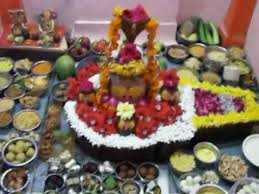
Navchandi Yagnya:
It means an oblation (Yagnya) of nine manifestations collectively—prayer, worship, sacrifice, devotion, donation, fasting etc—of fierce deity Durga. Chandi signifies a fierce deity. She is fierce and furious for and against vices or evils. Performing worship or the oblation of Navchandi (Yagnya) to her removes vices or evils from her devotees, not only that but it prevents and removes diseases, sickness or ailments from bodies.

Shatchandi Yagnya and Sahashrachandi Yagnya:
These oblations (Yagnya) are religiously performed by any people or family with the aid of the ritualist (Maharaj/Pandit) for 100 and 1000 godesses, respectively, in order to bring all sorts of religious happiness and peace in a family.
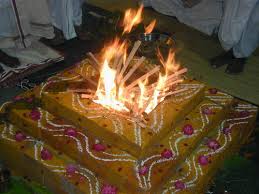
Shri Ganesh Yagnya:
The performance of this oblation to the lord Ganesh is religiously got performed by any person/s or family or business-owner/s or students, through the ritualist (Maharaj/Pandit) for the purpose of riches (Riddhi) and achievements (Siddhi) and progress & prosperity in their lives, education, marriages, launching or establishing of any business, trades, factories, hourse-warming (Vastu of a newly built house), a foundation-pit etc. Therefore, the lord Ganeshji’s idol is initially installed first, along with chanting by the ritualist of spells (Mantra) in Sanskrit language, before launching or beginning any auspicious acts, works, deeds or performances in any spheres of life and business.
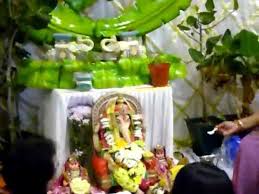
Kuber Yagnya or Maha Lakshmi Yagnya:
This oblation (Yagnya) is done by any person/s or family or any group of persons with the aid and along with the ritualist (Maharaj/Pandit) for progress and enhancement in riches in their lives. Both the words: Kuber and Lakshmi literally mean treasure, money, riches, wealth or affluence and prosperity from goddess of riches i.e. Lakshmiji that is called Maha Lakshmi because the riches is most significant in everybody’s quotidian mundane life (i.e. Sansarik Jivan) Therefore, Kuber-Pooja or Yagnya can be got performed on any day throughout a year. And likewise, Lakshmi-Poojan on every Deepawali/Diwali (festival of lights) is religiously and with ardent faith got performed with the aid of the ritualist (Maharaj), by every business owner, merchant, trader, family-member or institution or organization or field that is basically root or core factor for one’s income. The Deepawali/Diwali takes place on the Hindu calendar date: Aaso Vad Amaas i.e. Deepawali-day during the corresponding month of October in every year or November when there is one Addhik Maas (called Purushotam Maas)—an additional month—in the Hindu calendar. Even otherwise, anybody can get performed Kuber Yagnya and Maha Lakshmi Yagnya on any auspicious day throughout the year.
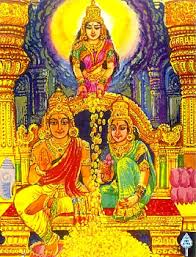
Kaal Sarp Dosh Vidhi:
The rites got performed religiously by the ritualist’s ritual attempts for abolishment of adverse effects on the fate of one’s life-long, by virtue of the influence of a fault (Dosh), caused by a celestial situation resulting from the existence or position or being of Rahu (the ascending node considered as one of the nine planets) & Ketu (the descending node considered as the ninth planet) in between of which of the two, all other remaining planets take their position at a time, when a person is born, is called Kaal Sarp Dosh Vidhi, as per one of the doctrines of the Astrology. This Kaal Sarp Dosh affects adversely and thereby causes many troubles, difficulties or hardships to any persons, if born under such an influence of it and they have to suffer and face various problems in the life. Therefore, any one born with and under such an influence may religiously get performed rites relating to this Kaal Sarp Dosh Vidhi, through the ritualist (Maharaj/Pandit), for removal of such fault (Dosh) and it is a must to get absorbed and diminished the effects of the Kaal Sarp Dosh, through the performance of the rites.
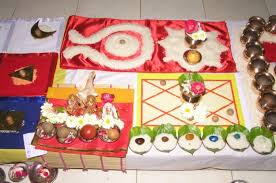
Bhoomi Poojan (Land Consecration):
Before getting or raising any constructions built on any land/s for the purpose of homes, factories, hospitals or any other industries or structures, it is religiously quite inevitable to get consecrated the land/s or a piece of land, upon which such constructions or structures have to be raised or built, through the performance by the ritualist and owner/s of the land/s of rites relating to the consecration of such land/s, with the aid and religious services of the ritualist, in order to remove the evil elements or adverse and bad aura attached with such land/s. And religiously, such lands become hallowed ones and there is no bar or no any hurdle is appeared set in. By and through such a performance of the rites of consecration, it is our prayer to the land-goddess to pardon us for pain and suffering endured by her, while excavating and constructing upon her (land-goddess) land. Under a consecration-process and religious performance for the land, one copper vessel containing small images made up of silver of a snake and a tortoise be placed into and sanctified an excavated hollow in a corner following the movement/transit of the Zodiac sign of the sun or as per the kind of the construction. Thus, the land/s become hallowed, through the chanting by Maharaj of religious spells (Mantro) in Sanskrit relating to the Bhoomi-Poojan i.e. Land Consecration.

Vaastu (House Warming):
It is one of the Hindu religious ceremonies, which is got performed and celebrated by the family-members through the religious service of the ritualist (Maharaj/Pandit) for the inauguration of their newly built residential house, before beginning to live in the new house and on this auspicious day, all relatives, friends and neighbors are cordially invited to attend this ceremonial religious function of Vaastu i.e. House Warming and to enjoy a grand feast arranged by the head of the family and his/her members. There is a reason why the Vaastu/House Warming of a newly built house is religiously held and celebrated before going in for living in it. The reason is that, while launching to construct or build a new house, innumerable living insects and creatures tiny to small, are injured or killed inadvertently during the digging of the pits for the house- foundation in the land.
And eight faults (Dosh) are found to have remained and prevailed, when building construction works take place on any land. The adverse effects resulting from the faults (Dosh)in the building-construction works and their influence upon the family may not rather bring home-happiness and peace to the family-members living in the new house, in case the Vaastu/House Warming is not held. So, to remove these faults (Dosh), one has to get performed religiously the Vaastu / House Warming occasion before shifting to the new house.
In the course of the performance of rites of the Vaastu; a little bit-amount of each of minerals, matters and substances like gold, silver, iron, bronze, lead, copper a piece of wood are utilized in the performance of Pooja. The accomplishment of performing of rites religiously and procedurally according to the spells and principles of the Hindu religion removes and absorbs faults (Dosh) and ultimately brings family-members the home-happiness and peace and long tenure of living in the new house.
Shanti or Shanti Path:
This religious activity is carried out and got performed with recitation of spells (Mantras) or texts for establishing peace in one’s life. There are several Shantis or Shanti Paths, briefed as follows:
A. Shri Navgrah Shanti: This spells-recitation is got performed religiously to liberate a person from the adverse effects of faults(Dosh) of nine planets, when s/he is born with bad influences resulting from the celestial positions of some of the nine planets occured at a particular time of the birth. No persons are feeble-minded when born; yet, their mental state seeming to be instability is because of adverse or bad effects of the positions of some of the planets at a particular time, they born with. Consequently, in horoscopes of such persons each, several bad or adverse-affecting faults are found. These faults (Dosh) as appearing in various horoscopes, in astrological parlance are called Shaapit Dosh; Vishyog Dosh; Angaarak Dosh; Mangal (Mars) Dosh; Shani (Saturn) Dosh; Pitru (Paternal ancestors) Dosh; Pret (Ghost/Spirit) Dosh; Grahan (Eclipse) Dosh and Dhan Hani (Wealth-loss) Dosh.
B. Nakshatra Shanti: That may be called the recitation of spells (Mantras) for the liberation from bad or adverse effect resulting from a constellation at a particular time a person born in and for the establishment of peace in life. If a person is born in a particular improper/bad Nakshatra (a constellation), that Nakshatra may cause many hardships in his/her life. These are Jayestha Nakshatra; Mul Nakshatra; Ashlesha Nakshatra, for which, the spells-recitations (mantras) are necessary to be removed religiously to prevent the bad or adverse effects and to establish peace in life.
C. Yog Shanti: The spell (Mantras)-recitation is religiously got performed to remove the bad or adverse effects of Yog (Period of time) and to establish peace in a person’s life, if s/he is born in such a Yog, as is not good, fruitful or beneficial but on the contrary produce bad effects under the influence or exposure of improper or bad time at the time of birth. This Yog may be classified into Vaidhruti Yog and Yatipaat Yog, the bad effects of which are necessary to be removed religiously or establishing peace and happiness in life, if a person is found to have been born in such an improper period of time.
D. Krishna Chatudarshi Shanti: This spells (Mantras)-chanting or recitation is got performed religiously for removal of darkness and bringing enlightenment in one’s life , when a person is born on the 14th day of Krishna Paksh, as per the Hindu calendar.
E. Grahan Shanti: This religious performance of chanting or reciting spells (Mantras) is got done to remove bad effects of an Eclipse (Grahan) and to bring light in one’s life, in case a person has been born in a period of time, when the sun or the moon eclipse occurred. As the eclipse (Grahan) makes us unable to see whole or part of the sun or the moon, as the case may be, likewise it may make a person’s life dull and full of hardships, overshadowing his /her fate or luck, if the person was born during the eclipse-period. So it is also necessary to get performed Grahan Shanti through the chanting or reciting of the religious spells (Mantras) of this Shanti.
Mantra Jap Vidhi:
This religious performance is done for the purpose of peace, comfort and happiness by devotees or people in general, through the aid and religious services of the ritualist (Maharaj/Pandit). In this performance, any particular Mantra is repeated. So it is called Mantra-Jap. There are several Mantra-Japs (Repitions of Spells) such as Maha Mrutunjaya Mantra; Lagna Vidhi i.e. wedding ceremonial performance, which is one of the religious performance-stages (Sanskars), which are 16 in numbers.
Other Religious Performances:
Other religious perfrmances are also carried out and performed by us with musical orchestra.such as Shri Satyanarayan Katha, Shri Sundarkanth Paath and Pran Pratishtha Mahotsav—i.e. religiously installation of God or Goddess Idol in a new temple.

























